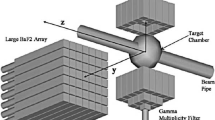Abstract
The dependence of the nuclear temperatures of highly excited systems, extracted by means of the double ratios of the emitted isotopes, on the experimental conditions is investigated. Experimental data obtained in the Xe+Cu 30 MeV/nucleon reaction are used to study the sensitivity of the method and the effects of the energy thresholds on the obtained temperature values. We find that the temperatures extracted using the He/Li ratios can be strongly influenced by the experimental energy thresholds which are different for different elements. These distortions depend on the velocity of the emitting system and on the detection angle and therefore particular care is needed in the choice of the detectors in those experiments in which velocities are low and angles are large. The use of four isotopes of the same element make negligible such effects.
Similar content being viewed by others
References
M.W. Curtain, H. Toki and D.K. Scott, Phys. Lett. B 123, 289 (1983).
A.D. Panagiotou, M.W. Curtain, H. Toki, D.K. Scott and P.J. Siemens, Phys. Rev. Lett. 52, 495 (1984).
G.F. Bertsch and P.J. Siemens, Phys. Lett. B 126, 9 (1983).
A.L. Goodman, J.I. Kapusta and A.Z. Mekjian, Phys. Rev. C 30, 851 (1984).
H.R. Jaqaman, G. Papp and D.H.E. Gross, Nucl. Phys. A 514, 327 (1990).
B. Jakobsson, G. Jönsson, B. Lindkvist and A. Oskarsson, Z. Phys. A 307, 293 (1982).
B. Jakobsson et al., Nucl. Phys. A 509, 195 (1990).
H.H. Gutbrod, A.I. Warwick and H. Wieman, Nucl. Phys. A 387, 177c (1982).
A.D. Panagiotou, M.W. Curtin and D.K. Scott, Phys. Rev. C 31, 55 (1985).
W.G. Lynch, Annu. Rev. Nucl. Part. Sci. 37, 493 (1987).
L.G. Moretto, Annu. Rev. Nucl. Part. Sci. 43, 379 (1993).
J.E. Finn et al, Phys. Rev. Lett. 49, 1321 (1982).
J. Pochodzalla et al., Phys. Rev. Lett. 75, 1040 (1995).
A. Kolomiets et al., Phys. Rev. C 54, R472 (1996).
M.J. Huang et al., Phys. Rev. Lett. 78, 1648 (1997).
R. Wada et al., Phys. Rev. C 55, 227 (1997).
F. Gulminelli and D. Durand, Nucl. Phys. A 615, 117 (1997).
Y.G. Ma et al., Phys. Lett. B 390, 41 (1997).
H.F. Xi et al., Phys. Rev. C 58, R2636 (1998).
J. A. Hauger et al., Phys. Rev. C 57, 764 (1998).
P.M. Milazzo et al., Phys. Rev. C 58, 953 (1998).
S. Albergo et al., Nuovo Cimento 89, 1 (1985).
M.B. Tsang et al., Phys. Rev. Lett. 78, 3836 (1997).
I. Iori et al., Nucl. Instrum. Methods Phys. Res. A 325, 458 (1993).
H.A. Bethe Ann. Phys. (Leipzig) 5, 325 (1930). H.H. Anderson and J.F. Ziegler Stopping Power and Ranges in All Elements (Pergamon Press, 1977); F. Hubert, R. Bimbot and H. Gauvin, Nucl. Instrum. Methods B 36, 357 (1989).
R.T. de Souza et al., Nucl. Instrum. Methods Phys. Res. A 295, 109 (1990).
C. Cavata et al., Phys. Rev. C 42, 1760 (1990).
P.M. Milazzo et al., Phys. Rev. C. 60, 044606 (1999).
Author information
Authors and Affiliations
Corresponding author
Additional information
Communicated by C. Signorini
Rights and permissions
About this article
Cite this article
Milazzo, P.M., Vannini, G., Bruno, M. et al. Nuclear temperature measurements with the double isotope ratio technique: Influence of the experimental conditions. Eur. Phys. J. A 8, 355–360 (2000). https://doi.org/10.1007/s100500070087
Received:
Revised:
Issue Date:
DOI: https://doi.org/10.1007/s100500070087




